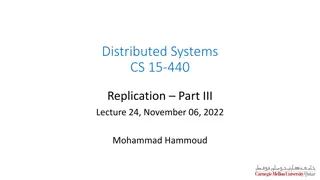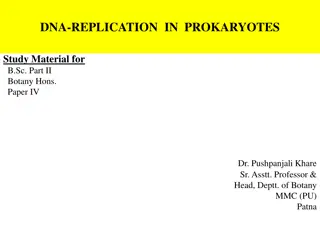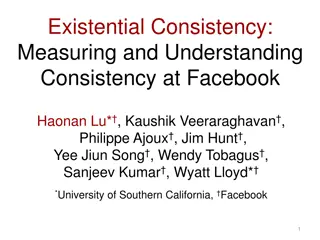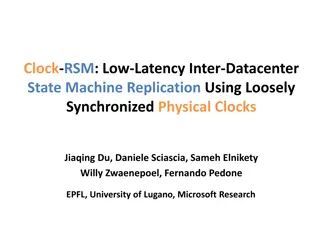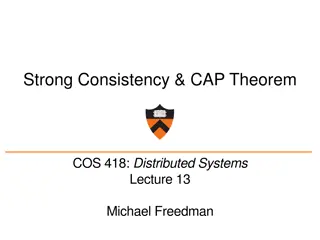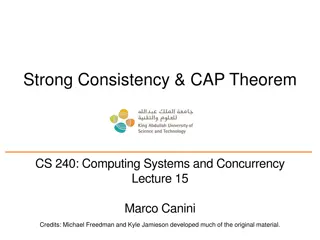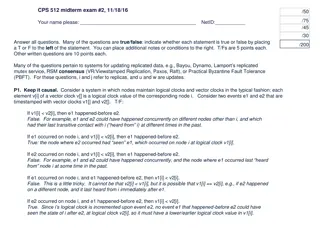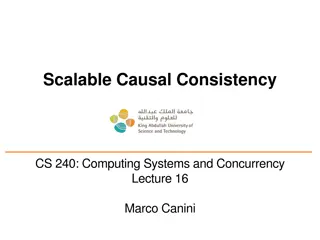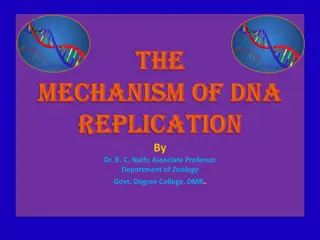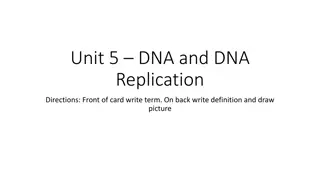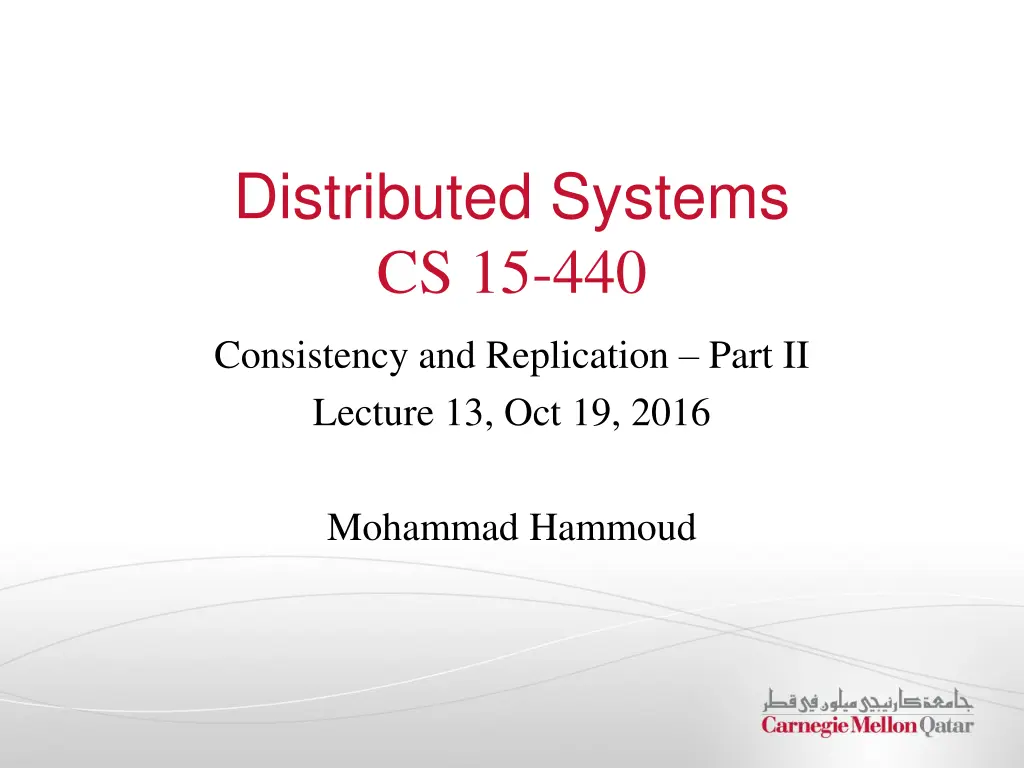
Distributed Systems: Consistency and Replication Models Overview
Explore the types of ordering in distributed systems, including total ordering, sequential ordering, and causal ordering. Delve into data-centric and client-centric consistency models, as well as replica management and server placement. Learn about the importance of maintaining consistency across distributed systems for various applications.
Download Presentation

Please find below an Image/Link to download the presentation.
The content on the website is provided AS IS for your information and personal use only. It may not be sold, licensed, or shared on other websites without obtaining consent from the author. If you encounter any issues during the download, it is possible that the publisher has removed the file from their server.
You are allowed to download the files provided on this website for personal or commercial use, subject to the condition that they are used lawfully. All files are the property of their respective owners.
The content on the website is provided AS IS for your information and personal use only. It may not be sold, licensed, or shared on other websites without obtaining consent from the author.
E N D
Presentation Transcript
Distributed Systems CS 15-440 Consistency and Replication Part II Lecture 13, Oct 19, 2016 Mohammad Hammoud
Today Last Session Consistency and Replication- Part I Today s Session Consistency and Replication Part III Data-Centric Consistency Models (Continue) Client-Centric Consistency Models Announcements: Mid-semester grades are out P2 is due on Sunday, Oct 23 by midnight 2
Overview Motivation Consistency Models Data-centric Consistency Models Client-centric Consistency Models Replica Management Replica Server Placement Content Replication and Placement 3
Types of Ordering We will study three types of orderings, which can be utilized by consistency models to agree upon and meet the needs of different applications: 1. Total Ordering 2. Sequential Ordering i. Sequential Consistency Model 3. Causal Ordering i. Causal Consistency Model 4
Types of Ordering 1. 2. 3. Total Ordering Sequential Ordering Causal Ordering 5
Total Ordering Total Order If process Pisends a message miand Pjsends mj, and if one correct process delivers mibefore mjthen every correct process delivers mibefore mj P1 P2 P3 m(1,1) m(3,1) Ex1: Total Order Messages can refer to replica updates In the example Ex1, if P1 issues the operation m(1,1): x=x+1; and If P3 issues m(3,1): print(x); and P1 or P2 or P3 delivers m(3,1) before m(1,1) Then, at all replicas P1,P2,P3 the following order of operations are executed print(x); x=x+1; P1 P2 P3 m(1,1) m(3,1) Ex2: Not in Total Order
Types of Ordering 1. 2. 3. Total Ordering Sequential Ordering Causal Ordering 7
Sequential Ordering If a process Pi sends a sequence of messages m(i,1),....,m(i,ni), and Process Pj sends a sequence of messages m(j,1),....,m(j,nj), Then: At any process, the set of messages received are in some sequential order Messages from each individual process appear in this sequence in the order sent by the sender At every process, mi,1should be delivered before mi,2, which is delivered before mi,3 and so on... At every process, mj,1should be delivered before mj,2, which is delivered before mj,3 and so on... P1 P2 P3 m(1,1) m(3,1) m(3,2) m(1,2) m(3,3) Valid Sequential Orders P1 P2 P3 m(1,1) m(3,1) m(3,2) m(1,2) m(3,3) Invalid Sequential Orders, but Valid Total Order
Sequential Consistency Model The Sequential Consistency Model entails that all update operations are executed at replicas in a sequential order Consider a data-store with variable x (Initialized to NULL) In the two data-stores below, identify the sequentially consistent data-store P1 P1 W(x)a W(x)a P2 W(x)b P2 W(x)b R(x)a R(x)a P3 R(x)b P3 R(x)b R(x)a R(x)b R(x)b R(x)a P4 P4 (a) Results while operating on DATA-STORE-1 (b) Results while operating on DATA-STORE-2 =Read variable x; Result is b = Write variable x; Result is b 9 W(x)b =Process P1 =Timeline at P1 P1 R(x)b
Sequential Consistency (Contd) Consider three processes P1, P2 and P3 executing multiple instructions on three shared variables x, y and z Assume that x, y and z are set to zero at start P1 P2 P3 x = 1 print (y,z) y = 1 print (x,z) z = 1 print (x,y) There are many valid sequences in which operations can be executed at the replica respecting sequential consistency Identify the output x = 1 print (y,z) y = 1 print (x,z) z = 1 print (x,y) x = 1 y = 1 print (x,z) print (y,z) z = 1 print (x,y) print (y,z) y = 1 print (x,y) x = 1 print (x,z) z = 1 y = 1 z = 1 print (x,y) print (x,z) x = 1 print (y,z) 101011 010111 Output 000110 001011 10
Implications of Adopting A Sequential Consistency Model for Applications There might be several different sequentially consistent combinations of ordering Number of combinations for a total of n instructions = ?(?!) The contract between the process and the distributed data-store is that the process must accept all of the sequential orderings as valid results A process that works for some of the sequential orderings and does not work correctly for others is INCORRECT 11
Types of Ordering 1. 2. 3. Total Ordering Sequential Ordering Causal Ordering 12
Causality (Recap) Causal relation between two events If a and b are two events such that a happened- before b (i.e., a b), and If the (logical) times when events a and b occur at a process Pi are denoted as Ci(a) and Ci(b) Then, if we can infer that a Ci(a)< Ci(b), then a and b are causally related b by observing that Causality can be implemented using Vector Clocks 13
Causal vs. Concurrent events Consider an interaction between processes P1 and P2 operating on replicated data x and y W(x)a W(x)a P1 P1 R(x)a W(y)b W(y)b R(x)a P2 P2 Events are not causally related Events are concurrent Computation of y at P2 does not depend on the value of x written by P1 Events are causally related Events are not concurrent Computation of y at P2 may have depended on the value of x written by P1 =Read variable x; Result is b = Write variable x; Result is b 14 =Process P1 =Timeline at P1 P1 R(x)b W(x)b
Causal Ordering Causal Order If process Pisends a message miand Pjsends mj, and if mi is Lamport s happened-before relation) then any correct process that delivers mjwill deliver mibefore mj P1 P2 P3 mj(operator m(1,1) m(3,1) m(1,2) In Ex1: Ex1: Valid Causal Orders m(1,1)and m(3,1) are in Causal Order and m(1,1)and m(1,2) are in Causal Order P1 P2 P3 m(1,1) m(3,1) m(1,2) Invalid Causal Order
Causal Consistency Model A data-store is causally consistent if: Writes that are potentially causally related must be seen by all the processes in the same order Concurrent writes may be seen in a different order on different machines 16
Example of a Causally Consistent Data-store Causal writes Concurrent writes P1 W(x)a W(x)c W(x)b P2 R(x)a R(x)a P3 R(x)a R(x)c R(x)b R(x)a R(x)b R(x)b R(x)c P4 A Causally Consistent Data-Store But not a Sequentially Consistent Data-Store =Read variable x; Result is b = Write variable x; Result is b 17 17 =Process P1 =Timeline at P1 P1 R(x)b W(x)b
Implications of adopting a Causally Consistent Data-store for Applications Processes have to keep track of which processes have seen which writes This requires maintaining a dependency graph between write and read operations Vector clocks provide a way to maintain causally consistent data-stores 18
Topics Covered in Data-centric Consistency Models Data-centric Consistency Models Models for Specifying Consistency Models for Consistent Ordering of Operations Continuous Consistency Model Sequential Consistency Model Causal Consistency Model But, is Data-Centric Consistency Model good for all applications? 19
Applications that Can Use Data-centric Models Data-centric models are applicable when many processes are concurrently updating the data-store But, do all applications need all replicas to be consistent? Webpage-A Webpage-A Webpage-A Webpage-A Webpage-A Webpage-A Event: Update Webpage-A Webpage-A Webpage-A Webpage-A Webpage-A Webpage-A Webpage-A Data-Centric Consistency Model is too strict when One client process updates the data Other processes read the data, and are OK with reasonably stale data 20
Overview Consistency Models Data-centric Consistency Models Client-centric Consistency Models Replica Management Replica Server Placement Content Replication and Placement 21
Client-Centric Consistency Models Data-centric models lead to excessive overheads in applications where: A majority operations are reads, and Updates occur infrequently, and are often from one client process For such applications, a weaker form of consistency called Client-centric Consistency is employed for improving efficiency Client-centric consistency models specify two requirements: 1. Eventual Consistency All the replicas should eventually converge on a final value 2. Client Consistency Guarantees A client should be guaranteed some level of consistency while accessing different replicas at different times 22
Overview Consistency Models Data-centric Client-centric Models for Consistent Ordering of Operations Models for Specifying Consistency Eventual Consistency Client Consistency Guarantees Continuous Consistency Model Sequential Consistency Model Causal Consistency Model 23
Eventual Consistency Many applications can tolerate inconsistency for a long time Webpage updates, Web Search Crawling, indexing and ranking, Updates to DNS Server In such applications, it is acceptable and efficient if replicas in the data-store rarely exchange updates A data-store is termed as Eventually Consistent if: All replicas will gradually become consistent in the absence of updates Typically, updates are propagated infrequently in eventually consistent data-stores 24
Designing Eventual Consistency In eventually consistent data-stores, Write-write conflicts are rare Two processes that write the same value are rare Generally, one client updates the data value e.g., One DNS server updates the name to IP mappings Such rare conflicts can be handled through simple mechanisms, such as mutual exclusion Read-write conflicts are more frequent Conflicts where one process is reading a value, while another process is writing a value to the same variable Eventual Consistency Design has to focus on efficiently resolving such conflicts 25
Challenges in Eventual Consistency Eventual Consistency is not good-enough when the client process accesses data from different replicas We need consistency guarantees for a single client while accessing the data-store Webpage-A Webpage-A Webpage-A Webpage-A Webpage-A Webpage-A Event: Update Webpage-A Webpage-A Webpage-A Webpage-A Webpage-A Webpage-A Webpage-A
Overview Consistency Models Data-centric Client-centric Models for Consistent Ordering of Operations Models for Specifying Consistency Eventual Consistency Client Consistency Guarantees Continuous Consistency Model Sequential Consistency Model Causal Consistency Model 27
Client Consistency Guarantees Client-centric consistency provides guarantees for a single client for its accesses to a data-store Example: Providing consistency guarantees to a client process for data x replicated on two replicas. Let xi be the local copy of a data x at replica Li. WS(x1) x+=2 x-=1 x*=5 W(x1)0 W(x1)2 W(x1)1 W(x1)5 L1 WS(x1;x2) x-=2 W(x2)0 R(x2)5 WS(x1) W(x2)3 L2 WS(x1) = Write Set for x1 = Series of ops being done at some replica that reflects how L1 updated x1 till this time = Write Set for x1and x2 = Series of ops being done at some replica that reflects how L1 updated x1 and, later on, how x2 is updated on L2 WS(x1;x2) 28 = Read variable x at replica i; Result is b = Write variable x at replica i; Result is b = Replica i WS(xi) = Write Set R(xi)b W(x)b Li
Client Consistency Guarantees 1 We will study four types of client-centric consistency models 1. Monotonic Reads 2. Monotonic Writes 3. Read Your Writes 4. Write Follow Reads 29 1. The work is based on the distributed database system built by Terry et al. [1]
Overview Consistency Models Data-centric Client-centric Client Consistency Guarantees Eventual Consistency Write Follow Reads Monotonic Reads Monotonic Writes Read Your Writes 30
Monotonic Reads The model provides guarantees on successive reads If a client process reads the value of data item x, then any successive read operation by that process should return the same or a more recent value for x Order in which client process carries out the operations WS(x1) R(x1) L1 WS(x1;x2) R(x2) L2 Result of R(x2) should at least be as recent as R(x1) 31
Monotonic Reads Puzzle Recognize data-stores that provide monotonic read guarantees WS(x1) R(x1)5 WS(x1) R(x1)5 L1 L1 W(x2)6 R(x2)6 W(x2)6 R(x2)6 WS(x1;x2) WS(x2) L2 L2 FIGURE 1 FIGURE 2 WS(x2;x1) R(x1)7 WS(x1) R(x1)5 L1 W(x2)6 R(x2)6 W(x2)7 WS(x1;x2) L2 FIGURE 3 32
Overview Consistency Models Data-centric Client-centric Client Consistency Guarantees Eventual Consistency Write Follow Reads Monotonic Reads Monotonic Writes Read Your Writes 33
Monotonic Writes This consistency model assures that writes are monotonic A write operation by a client process on a data item x is completed before any successive write operation on x by the same process A new write on a replica should wait for all old writes on any replica W(x1) W(x1) L1 L1 WS(x1) W(x2) W(x2) L2 L2 W(x2) operation should be performed only after the result of W(x1) has been updated at L2 The data-store does not provide monotonic write consistency 34
Monotonic Writes An Example Example: Updating individual libraries in a large software source code which is replicated Updates can be propagated in a lazy fashion Updates are performed on a part of the data item Some functions in an individual library is often modified and updated Monotonic writes: If an update is performed on a library, then all preceding updates on the same library are first updated Question: If the update overwrites the complete software source code, is it necessary to propagate all the previous updates? 35
Overview Consistency Models Data-centric Client-centric Client Consistency Guarantees Eventual Consistency Write Follow Reads Monotonic Reads Monotonic Writes Read Your Writes 36
Read Your Writes The effect of a write operation on a data item x by a process will always be seen by a successive read operation on x by the same process Example scenario: In systems where password is stored in a replicated data-base, the password change should be seen at all replicas W(x1) W(x1) L1 L1 WS(x2) R(x2) WS(x1;x2) R(x2) L2 L2 A data-store that does not provide Read Your Write consistency R(x2) operation should be performed only after the updating of the Write Set WS(x1) at L2 37
Overview Consistency Models Data-centric Client-centric Client Consistency Guarantees Eventual Consistency Write Follow Reads Monotonic Reads Monotonic Writes Read Your Writes 38
Write Follow Reads A write operation by a process on a data item x following a previous read operation on x by the same process is guaranteed to take place on the same or a more recent value of x that was read Example scenario: Users of a newsgroup should post their comments only after they have read the article and (all) previous comments R(x1) R(x1) WS(x1) WS(x1) L1 L1 WS(x1;x2) W(x2) WS(x2) W(x2) L2 L2 W(x2) operation should be performed only after all previous writes have been seen A data-store that does not guarantee Write Follow Read Consistency Model 39
Summary of Client-centric Consistency Models Client-centric Consistency Model defines how a data-store presents the data value to an individual client when the client process accesses the data value across different replicas It is generally useful in applications where: one client always updates the data-store read-to-write ratio is high Each client s processes should be guaranteed some level of consistency while accessing the data value from different replicas Client-centric Consistency Models All replicas will gradually become consistent in the absence of updates Eventual Consistency Client Consistency Guarantees Monotonic Reads Monotonic Writes Read Your Writes Write Follow Reads 40
Topics Covered in Consistency Models Consistency Models Data-centric Client-centric Models for Consistent Ordering of Operations Models for Specifying Consistency Client Eventual Consistency Consistency Guarantees Continuous Consistency Model Sequential Consistency Model Causal Consistency Model Monotonic Reads Monotonic Reads Read your writes Write follow reads 41
Summary of Consistency Models Different applications require different levels of consistency Data-centric consistency models Define how replicas in a data-store maintain consistency across a collection of concurrent processes Client-centric consistency models Provide an efficient, but weaker form of consistency One client process updates the data item, and many processes read the replica Define how replicas in a data-store maintain consistency for a single process 42
Next Class + Replica Management + Consistency Protocols We study how consistency is enforced in distributed systems Programming Models- Part I 43
References [1] Terry, D.B., Demers, A.J., Petersen, K., Spreitzer, M.J., Theimer, M.M., Welch, B.B., "Session guarantees for weakly consistent replicated data", Proceedings of the Third International Conference on Parallel and Distributed Information Systems, 1994 [2] Lili Qiu, Padmanabhan, V.N., Voelker, G.M., On the placement of Web server replicas , Proceedings of IEEE INFOCOM 2001. [3] Rabinovich, M., Rabinovich, I., Rajaraman, R., Aggarwal, A., A dynamic object replication and migration protocol for an Internet hosting service , Proceedings of IEEE International Conference on Distributed Computing Systems (ICDCS), 1999 [4] http://www.cdk5.net 44

